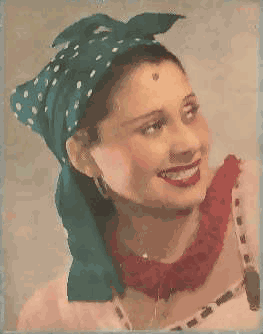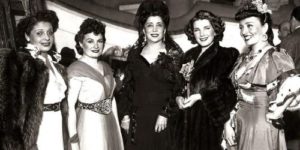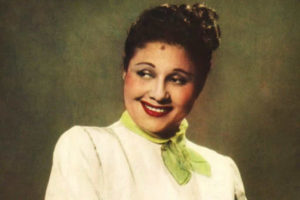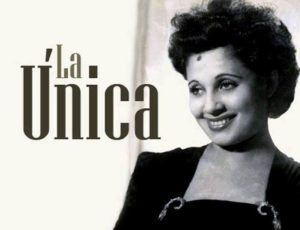 RITA MONTANER, “RITA DE CUBA”, UNA VOZ IMBORRABLE EN LA MUSICA CUBANA.
RITA MONTANER, “RITA DE CUBA”, UNA VOZ IMBORRABLE EN LA MUSICA CUBANA.
Rita Aurelia Fulcida Montaner y Facenda, mas conocida como Rita Montaner “La Única”, fue una cantante, pianista y actriz cubana, una vedette muy conocida tambien en Mexico City, Paris, Miami and New York, donde actuó, filmó e imprimió numerosas e inolvidables melodias musicales.
Nacida en Guanabacoa, Cuba, un 20 de Agosto de 1900 fue protagonista de varias leyendas de la cultura cubana, Rita Montaner legó triunfos irrefutables en todas las manifestaciones artísticas y escenarios del orbe, que todavía hoy son recordados.
Desde temprana edad su vida transcurrió en medio de la música clásica, los toques de tambor y las alegres comparsas que desfilaban por su natal Guanabacoa, cuna también de otros grandes de la música, entre estos Ignacio villa (Bola de Nieve), Ernesto Lecuona y Enriqueta Sierra.
Fue una niña precoz que estudió el piano hasta lograr la más plena perfección, dominaba el pentagrama y cantaba de manera excelente, con un estilo suyo, muy peculiar, tanto las melodías cultas como las populares, algo que no ha podido ser igualado.
Con sólo 22 años de edad, devino la primera voz femenina que se escuchó por el medio radial en Cuba.
El acontecimiento tuvo lugar a través de la emisora PWX, de la otrora Compañía Telefónica, durante la inauguración de la radio en la isla caribeña y estuvo acompañada por la orquesta que dirigía Luis Casas Romero.
Años después debutó en la zarzuela Niña Rita, de Ernesto Lecuona, y Ay Mama Inés, de Eliseo Grenet, piezas antológicas del cancionero criollo cubano. Francia, Estados Unidos y otros afamados escenarios del mundo vieron triunfar a la excelsa cantante cuya versión de Cecilia Valdés hizo que el autor, Gonzalo Roig, calificara la interpretación de genial, artística y sobresaliente.
El teatro, la radio, el cine y la televisión, acogieron sus presentaciones dentro y fuera de Cuba con tal maestría, que recibió los elogios de la crítica especializada, ovaciones del público y el respeto de artistas de todo el orbe.
En ese sentido destaca la vedette Josephine Baker, quien fascinada por la Montaner, la invitó a participar en uno de sus espectáculos, y después recorrió escenarios de Estados Unidos, España, Argentina, Venezuela y México.
Aunque su mayor desarrollo fue como cantante de arte lírico, se destacó también como actriz en la gran pantalla en cintas como El romance del palmar (1938), Sucedió en La Habana y María La O, así como producciones del séptimo arte en México.
Con una esmerada educación en piano, gran carácter y una entrega indiscutible a las artes en general, su impronta trascendió las fronteras nacionales por su talento extraordinario basado en la versatilidad para moverse por los distintos géneros de la música cubana.
En cada actuación Rita Montaner reafirmaba su auténtica cubanía. Sólo ella, y nadie más, ha hecho del solar habanero, de la calle cubana, una categoría universal, dijo el poeta Nicolás Guillén.
La cantante, con su perseverancia, contribuyó a destruir los prejuicios de aquellos que menospreciaban los aportes africanos a la música cubana.
El poeta y declamador Luis Carbonell afirmó que ella imprimía a la música negra una especie de desgarramiento que producía con las cuerdas vocales. «Hacía un desgarramiento doloroso, un alarido de protesta, como nadie ha podido hacerlo en nuestro país».
De la genial intérprete de Rosa La China, del maestro Lecuona, manifestó el escritor y poeta Miguel Barnet: Su estilo tenía de africano y español, pero sobre todo y para siempre, de nuestros ingredientes, de nuestra cosecha nacional.
Casada con Ernesto Estevez Nacarro (1933-1938), Xavier Cugat (1918-1920) y el Dr. Alberto Fernández Diaz (1932)
Hijos: Rolando y Alberto.
Rita falleció a los 58 años cuando el cáncer se robó poco a poco su voz, hasta terminar con su vida el 17 Abril de 1958 en La Habana.
 RITA MONTANER, “RITA OF CUBA”, AN UNBEATABLE VOICE IN CUBAN MUSIC.
RITA MONTANER, “RITA OF CUBA”, AN UNBEATABLE VOICE IN CUBAN MUSIC.
Rita Aurelia Fulcida Montaner y Facenda, better known as Rita Montaner “La Única”, was a Cuban singer, pianist, and actress, a well-known star also in Mexico City, Paris, Miami, and New York, where she performed, filmed and printed numerous and unforgettable musical melodies.
Born in Guanabacoa, Cuba, on August 20, 1900, she was the protagonist of several legends of Cuban culture, Rita Montaner bequeathed irrefutable triumphs in all the artistic manifestations and stages of the world, which are still remembered today.
From an early age, his life passed in the midst of classical music, the drumming, and the happy troupes that paraded through his native Guanabacoa, also the cradle of other greats of music, among these Ignacio Villa (Bola de Nieve), Ernesto Lecuona and Enriqueta Sierra.
She was a precocious girl who studied the piano to the fullest perfection, mastered the staff and sang excellently, with her own style, very peculiar, both cultured and popular melodies, something that could not be equaled.
https://youtu.be/-PFg7axsw4k
At only 22 years old, she became the first female voice to be heard on the radio in Cuba.
The event took place through the PWX station, from the former Telephone Company, during the inauguration of the radio on the Caribbean island, and was accompanied by the orchestra led by Luis Casas Romero.
Years later he debuted in the zarzuela Niña Rita, by Ernesto Lecuona, and Ay Mama Inés, by Eliseo Grenet, anthological pieces of the Cuban Creole songbook. France, the United States, and other famous stages of the world saw the exalted singer triumph whose version of Cecilia Valdés caused the author, Gonzalo Roig, to describe the performance as brilliant, artistic, and outstanding.
The theater, radio, cinema, and television welcomed their presentations inside and outside of Cuba with such mastery, that they received the praise of specialized critics, ovations from the public, and the respect of artists from all over the world.
In this sense, the vedette Josephine Baker stands out, who, fascinated by Montaner, invited her to participate in one of her shows and later toured stages in the United States, Spain, Argentina, Venezuela, and Mexico.
Although her greatest development was as a lyrical art singer, she also stood out as an actress on the big screen in films such as El romance del palmar (1938), It Happened in Havana and María La O, as well as productions of the seventh art in Mexico.
With a careful piano education, great character, and an indisputable dedication to the arts in general, his imprint transcended national borders for his extraordinary talent based on the versatility to move through the different genres of Cuban music.
In each performance, Rita Montaner reaffirmed her authentic Cubanness. Only she, and no one else, has made the Havana lot of the Cuban street a universal category, said the poet Nicolás Guillén.
The singer, with her perseverance, contributed to destroy the prejudices of those who underestimated the African contributions to Cuban music.
The poet and declaimer Luis Carbonell affirmed that she gave black music a kind of tear that is produced with the vocal cords. “It was a painful tear, a howl of protest, as no one has been able to do in our country.”
The writer and poet Miguel Barnet said of the great interpreter of Rosa La China, by maestro Lecuona: His style was African and Spanish, but above all and forever, of our ingredients, of our national harvest.
Married to Ernesto Estevez Nacarro (1933-1938), Xavier Cugat (1918-1920) and Dr. Alberto Fernández Diaz (1932)
Children: Rolando and Alberto.
Rita died at 58 when cancer slowly stole her voice, ending her life on April 17, 1958, in Havana.
Agencies/ RHC/ Teresita Jorge/ Lorena Viñas/ Internet Photos/ YouTube/ www.TheCubanHistory.com
THE CUBAN HISTORY, HOLLYWOOD.









